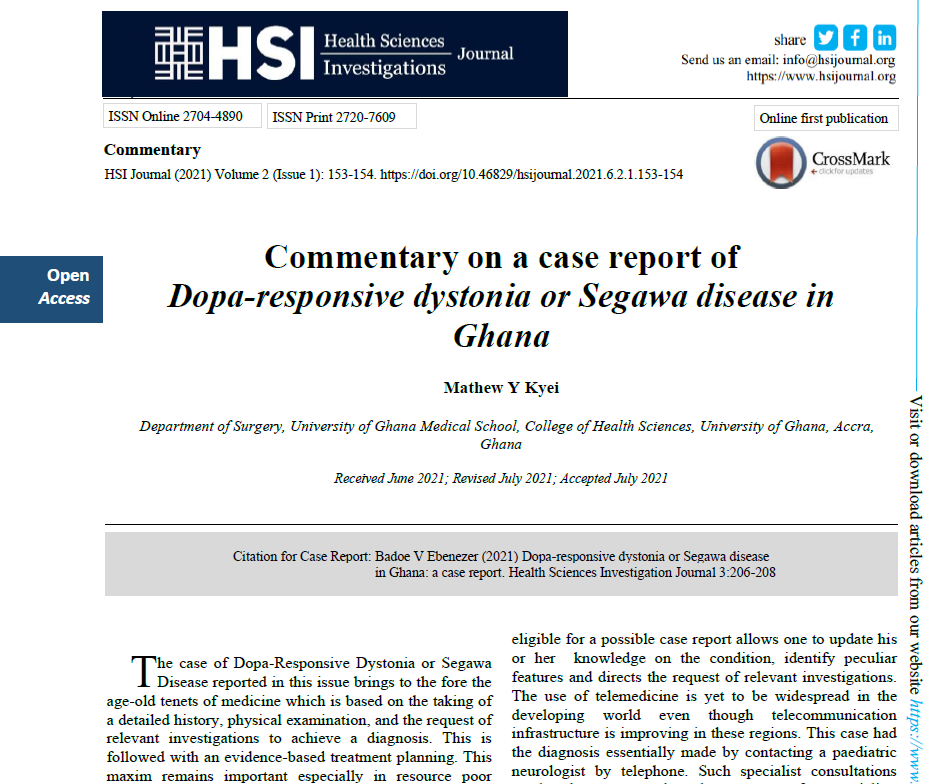Commentary on a case report of Dopa-responsive dystonia or Segawa disease in Ghana
Abstract
The case of Dopa-Responsive Dystonia or Segawa Disease reported in this issue brings to the fore the age-old tenets of medicine which is based on the taking of a detailed history, physical examination, and the request of relevant investigations to achieve a diagnosis. This is followed with an evidence-based treatment planning. This maxim remains important especially in resource poor environments where sometimes one must depend on the history and physical examination findings alone to make a diagnosis and commence treatment. The patient under review had had her condition progressively worsening for two years and had been managed as a case of cerebral palsy.
The initial consideration of a possible dyskinetic cerebral palsy from bilirubin encephalopathy which the author indicated was common is understandable as this is one of the commonest causes of such presentation in the setting. However, having a more detailed history and having other differentials in mind such as childhood Dopa-Responsive Dystonia, as was the case presented, helped in identifying subtle differences in presentation that influenced the ultimate diagnosis. In this case, a later onset of symptoms (dystonia), with the symptoms being minimal after sleep and becoming more severe late afternoon having helped to clinch the diagnosis. Considering each patient one sees as eligible for a possible case report allows one to update his or her knowledge on the condition, identify peculiar features and directs the request of relevant investigations. The use of telemedicine is yet to be widespread in the developing world even though telecommunication infrastructure is improving in these regions. This case had the diagnosis essentially made by contacting a paediatric neurologist by telephone. Such specialist consultations need to be encouraged as there are very few specialists across the globe and less still in the developing economies.
Governments and Medical Associations may have to lead in creating these platforms to assist in this direction to improve the overall access to specialist care and reviews in less endowed regions. In the case presented, the diagnosis of Dopa-Responsive Dystonia was confirmed after a demonstration of a marked and sustained response to low dose L-dopa without motor fluctuations or dyskinesias. We applaud the author for the diagnosis having been made by essentially a detailed history and physical examination and response to L-dopa. It was however indicated that there are recent developments that involve analysis of cerebrospinal fluid for neurotransmitters that demonstrate low concentrations of biopterin and neopterin with DNA sequencing demonstrating mutation of the GTP cyclohydrolase-1 gene in up to 80% of cases in gene studies. These diagnostic tests hinge on the finding of an autosomal dominant heterozygous mutation in the GTPcyclohydrolase-I gene that results in biopterin deficiency, a cofactor for tyrosine hydroxylase and dopamine deficiency and considered the most classic molecular pathophysiology of this condition [1]. These additional tests were not done bringing to the fore the limited access to investigative tools in some developing economies. While National Reference Laboratories are in existence in some countries, regional efforts could be made to set up reference laboratories that serve entire region to allow for pooling of infrequently performed laboratory tests for analysis. This will make such infrequently encountered medical conditions be accurately diagnosed and treated. Of concern is how to achieve an un-interrupted supply of L-Dopa as the child returns to the village. This should engage the attention of all involved in her treatment as they follow the patient up.
To conclude, the suggestion by the author that the diagnosis of Dopa-Responsive Dystopia or Segawa disease must be considered in all cases of dystonia including cases of apparent dystonic cerebral palsy and especially where there is no history of birth asphyxia need being emphasized.


